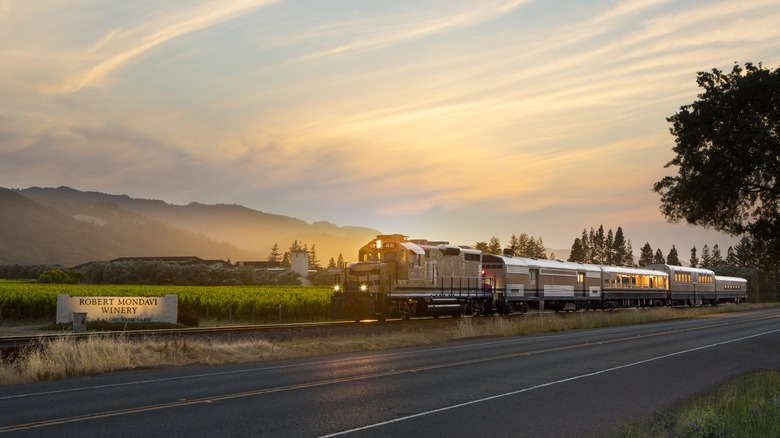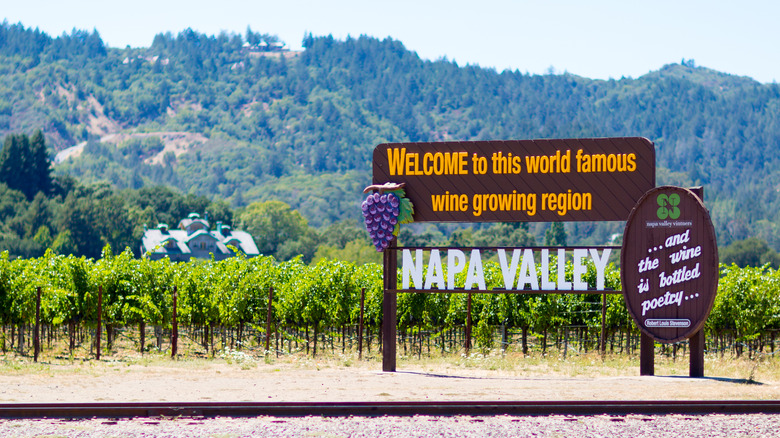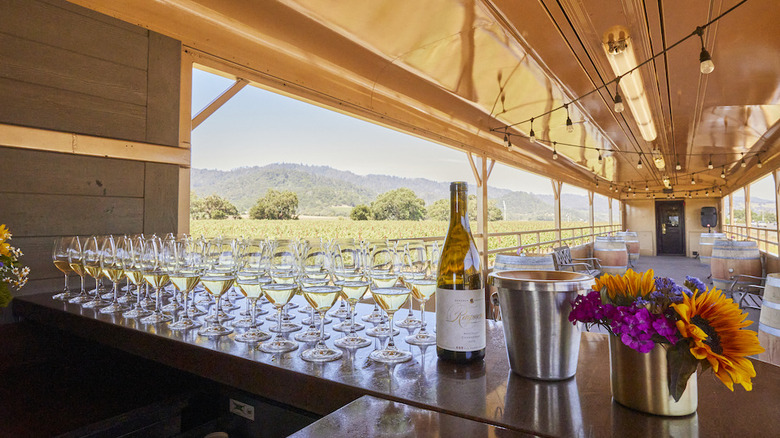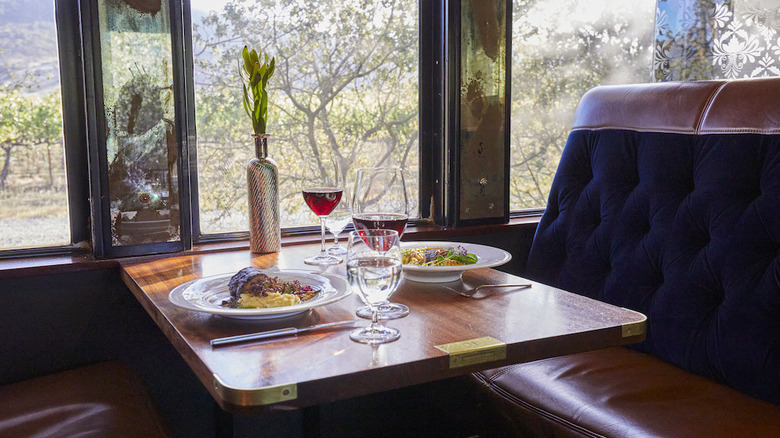Explore Napa Valley's Wine Country Aboard A Luxurious And Historic Train
Let's cut to the chase. Transportation is one of the biggest challenges oenophiles face when they're exploring wine country. That's especially true in a place like Napa Valley where proximity makes it easy, even preferable, to visit several wineries in one day. In fact, Visit Napa Valley says it's reasonable to plan on visiting as many as three wineries per day. If you plan on spending an average of 90 minutes at each vineyard, a three-a-day itinerary leaves plenty of leeway for travel between tastings. California Winery Advisor says, with proper planning, it's possible to visit up to eight Napa Valley wineries in one day — especially if they're in close proximity — but suggests five is probably the sweet spot for most people, especially those who are drinking, not spitting.
That's all well and good, but there's a catch — especially if you're planning a do-it-yourself itinerary. Who's going to drive? It's a valid question. Despite the laissez-faire, live-in-the-moment approach we'd all like to embrace during a meandering drive through wine country, the logistics, if you're tasting, can be complicated. Hiring a car is a popular option. Visit Napa Valley offers a slew of suggestions for finding the right service or driver, including a luxe train tour.
Don't wing it
If you're creating your own wine-tasting itinerary, California Winery Advisor offers some worthy considerations. First up: Know your limits and plan accordingly. Those itsy-bitsy tasting glasses add up. On average, you'll taste four to six one-ounce pours at each winery you visit. If you're drinking, not tasting and spitting, that adds up to about one full glass of wine per stop.
Walking tours are an option in some places. Consider Tin City in Paso Robles or the Funk Zone in Santa Barbara where, according to California Wine Advisor, you'll find up to 10 wineries within easy walking distance of one another. On the other hand, drive time between wineries located in the Santa Cruz mountains averages 15 to 20 minutes.
If you're planning to wing it, Visit Napa Valley offers a word to the wise: Don't. Some of Napa Valley's wineries book out weeks in advance. Without a reservation, you may be out of luck. Also, be sure to factor in tasting fees. The per-person tasting fee at a Napa Valley winery averages $40 for a basic tasting. Add in a tour or a pairing menu and you're looking at up to $200 per person. If you're serious about purchasing wine, though, some wineries will waive the tasting fee with a minimum spend. And don't forget to tip your host — $10 to $15 for a stand-up tasting and up to $20 for a seated tasting.
All aboard
One of the most unique, and potentially carefree ways, to tour Napa Valley is by train. But it's not just any train. The Napa Valley Wine Train runs along a rail line dating to 1864, built to traverse a 36-mile route between St. Helena and the 19th-century resort town of Calistoga. The line was all but abandoned in the early 20th century and finally offered for sale in 1984. That's when a group of Napa Valley residents stepped in to save the line, creating The Society for the Preservation of the Napa County Railroad. After a series of fits and starts, investors finally secured the line and began acquiring antique rail cars and staffing up to offer an upscale train tour through Napa Valley. The newly refurbished Napa Valley Wine Train left the station for its inaugural run on September 16, 1989.
Today, the wine train offers a variety of experiences and itineraries. Journeys begin at the McKinstry Street Station in downtown Napa for half- and full-day wine-tasting tours, in addition to lunch and dinner service. En route to St. Helena, the train passes through Yountville, Oakville, and Rutherford. Among others, partner wineries include Robert Mondavi, Domaine Chandon, and St. Supery.
Wine and dine
We mentioned the Napa Valley Wine Train isn't just any train. It's more like a step back in time. Guests settle into vintage Pullman rail cars retrofitted to reflect the elegance of early 20th-century rail travel. Brass fittings accent Honduran mahogany paneling and etched-glass partitions separate seating areas. Highlights include the 1952 #1085 Pullman Standard Dome Car, one of Pullman's first 10 full-dome cars, and the 1915 #1015 Pullman Dining Car, which was built for the Northern Pacific Railway and was part of the Denver Ski Train when the Napa Valley Wine Train acquired it in 1990 (via TrainWeb).
And then there's the food. According to FSR Magazine, Chef Rodrigo Cuadra joined the Napa Valley Wine Train culinary team as executive chef in 2022. Classically trained in the art of French cuisine, Cuadra previously worked as a sous chef under the tutelage of Michelin-star chef Thomas Keller. His background includes stints at Mandarin Oriental and Four Seasons.
Consider the Napa Valley Wine Train Legacy Experience. The six-hour tour includes tastings at Charles Krug and V. Sattui wineries in addition to breakfast (smoked salmon eggs Benedict, anyone?) and a four-course menu, served on board between tasting stops, with entree options like cracked mustard-cider glazed salmon, grilled tenderloin of beef, pork tenderloin, and seasonal risotto, followed by a ciabatta crisp with whipped local Brie, honey, olives, and fennel pollen.



